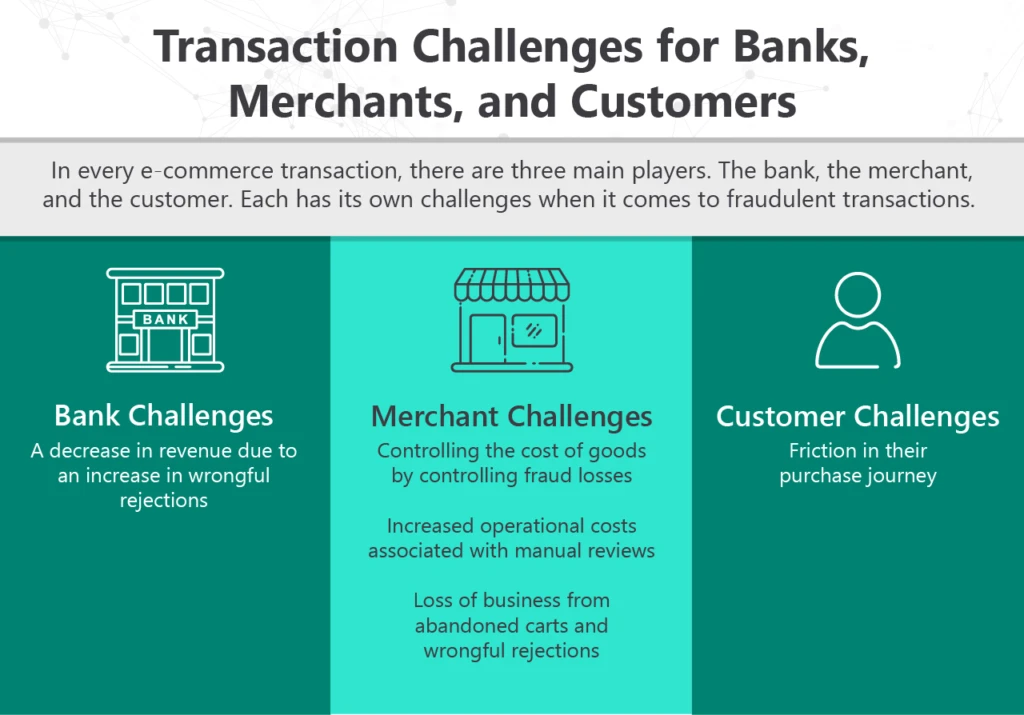
Create an amazing e-commerce customer experience with fraud protection
Fraud is a huge barrier for everyone involved in an e-commerce transaction. From the bank, to the merchant, and the customers themselves, fraud prevention can add friction to the customer experience and cause inaccurate approvals or wrongful rejections that result in increased operational costs and, ultimately, decreased revenue.
There is a new approach to fraud protection that removes this friction for the customer and addresses challenges for both the merchant and the bank. This approach is a customer purchase journey focus to fraud protection.
We’ll walk you through this approach, but first, let’s look at the challenges in a little more detail.
Transaction challenges for banks, merchants, and customers
In every e-commerce transaction, there are three main players. The bank, the merchant, and the customer. Each has its own challenges when it comes to fraudulent transactions.
The bank’s main challenge is a decrease in revenue due to an increase in wrongful rejections.

The merchant’s challenges include:
- Controlling the cost of goods by controlling fraud losses
- Increased operational costs associated with manual reviews
- Loss of business from abandoned carts and wrongful rejections
The customer is front-and-center for banks and merchants alike. So, the customer’s challenges are pain-points for banks and merchants as well. The main challenge for the customer is friction in their purchase journey.
Customers often need to complete multiple steps of authentication before they can complete a purchase.
Whether it’s multifactor authentication, technological barriers like CAPTCHA or phone challenges, the need to move through multiple steps to complete a transaction often leads to abandoned shopping carts and going to other merchants.
How can fraud protection remove some friction from the customer purchase journey?
The customer purchase journey
Unlike a brick-and-mortar storefront, when an online shopper visits an e-commerce store, they come to the merchant portal (store) anonymously. They can also interact with the platform in an anonymous fashion with actions like searching inventory and browsing.
At some point, the merchant will ask the shopper to identify themselves by taking an action such as creating a customer account. After creating the account, they may edit their information to include their shipping and billing addresses, payment information, preferences, etc.
Now, the shopper can add items to their shopping cart and make purchases.
Here, as Anand Oka, Principal Program Manager at Microsoft points out, is where many of us typically think of fraud occurring, at the time of purchase. But Oka says that fraud happens at all of these stages as well as the post-purchase stage.
Recognizing this fact and identifying the sort of actions a fraudulent shopper may make can help with a preventative, rather than reactionary, fraud protection posture.
“Just like we want to make the journey smooth for a real customer or a genuine customer you also want to make sure that you protect all these epochs from fraudulent activity.” –Anand Oka, Principal Group Program Manager at Microsoft
Watch the full interview with Anand Oka, Principal Group Program Manager at Microsoft.
So, the paradigm shift is to look at fraud protection from the perspective of the entire customer journey.
This is where leaders in fraud protection, like Ekata, thrive. Ekata looks at the entire customer purchase journey, going beyond transaction verification to verify email addresses, phone numbers, physical addresses, and IP addresses. In this way, a shopper’s identity can be identified as legitimate or fraudulent throughout their purchase journey before they make a purchase.
Beyond verification along the purchase journey, Microsoft and Ekata both prioritize the overall customer experience.
Ekata helps cross-border digital commerce companies grow their revenue by maximizing predictability of good transactions. From their Transaction Risk API delivered in under 100 milliseconds for pre-authorization models through to their robust manual review tool, Pro Insight, Ekata’s identity verification product suite verifies over 1.8 billion requests per year in 238 countries for over 1,700 companies.
“…the minute they hit the page, the minute they create an account, the minute they hit submit to ask for a pre-authorization of a transaction, the further ahead they can get in assessing the risk and understanding their customer the better they can give their customer an experience and increase that revenue.” –Katie McGinn, Head of e-commerce at Ekata
Watch the interview with Ekata Head of e-commerce, Katie McGinn.
Benefits of a customer journey focused fraud protection
Taking a customer purchase journey focused fraud protection stance alleviates many transaction challenges currently faced by banks, merchants, and customers.
Reduce operational expenses
With account creation protection and a network that provides a collective knowledge of fraudulent behaviors, you can reduce fraud losses and manual review expenses.
Increase acceptance rates
Decreasing wrongful rejections increases acceptance rates and, ultimately, your revenue.
Seamless customer experience
Reducing the frequency of challenges and friction in the shopping experience makes for a better customer experience. A better customer experience leads to more completed transactions and increased revenue for the merchant and banks.
How Dynamics 365 Fraud Protection helps
Dynamics 365 Fraud Protection addresses all of these challenges for the customer, merchant, and bank.
- The customer: Dynamics 365 Fraud Protection is customer-centric, providing customers with a superior shopping experience by reducing challenges in logging on as the vectors of data help Fraud Protection understand fraud better, which helps avoid the need for CAPTCHA, etc.
- The merchant: By reducing fraud while ensuring that wrongful rejects are lowered and increasing the bank acceptance rate, Fraud Protection not only helps merchants reduce operational costs associated with manual reviews, it also increases revenue for the merchant.
- The bank: Finally, Dynamics 365 Fraud Protection helps the bank boost acceptance rate and increase their revenue stream.
Learn more
Learn more about Dynamics 365 Fraud Protection and how to boost your customers’ purchase journey.



